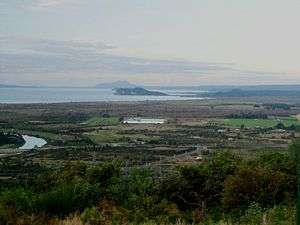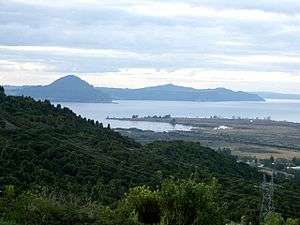Ngāti Tūwharetoa
| Ngāti Tūwharetoa | |
| Iwi of New Zealand | |
|---|---|
 Eastern Lake Taupo, Turangi to Taupo | |
 | |
| Rohe (location) | Central North Island |
| Waka (canoe) | Arawa |
| Population | 29,301 |
| "United Tribes" number | 46 |
| Website | http://www.tuwharetoa.iwi.nz/ |
Ngāti Tūwharetoa is an iwi (Māori tribe) descended from Ngātoro-i-rangi, the priest who navigated the Arawa canoe to New Zealand. The Tūwharetoa region extends from Te Awa o te Atua (Tarawera River) at Matata across the central plateau of the North Island to the lands around Mount Tongariro and Lake Taupo.
Tūwharetoa is the sixth largest iwi in Aotearoa with a population of 30,000 (NZ Census 2001) comprising a number of hapu (subtribes) represented by 33 marae. This collective is bound together by the legacy of Ngātoro-i-rangi as epitomised in the Ariki (Paramount Chief). 40% of Ngāti Tūwharetoa are under the age of 15.
History
Ngāti Tūwharetoa are descendants of the eponymous male warrior Tūwharetoa i te Aupouri. He was born as in Onepu (Kawerau) ca. 1300. The main Tribal areas of his people are based from Te Awa o te Atua in Matata to Tongariro. He gains his mana principally from the powerful tohunga and navigator Ngātoro-i-rangi who piloted the great waka Te Arawa from Hawaiki to Aotearoa & also the great navigator Toroa of the Mataatua waka. Ngātoro-i-rangi was tricked onto the Te Arawa waka by the chief Tama-te-kapua as it was considered good luck to have him aboard. He was originally destined to travel aboard the Tainui waka. This greatly angered Ngātoro-i-rangi and his disdain and animosity of the Te Arawa chief led to his leaving the group soon after arrival.
In Aotearoa they made landfall at Te Awa o Te Atua, and Ngātoro-i-rangi departed heading inland to Te Takanga i o Apa (Kawerau area), thence to Ruawahia where he encountered the monstrous Tama o Hoi and eventually reaching Taupo district where he climbed Mount Tauhara.
From Tauhara, Ngātoro-i-rangi made his way to Tongariro with the intention of standing on its summit and thus claiming the district as his own. While climbing the mountain a powerful southerly wind whipped his face, icy gales chiselled the warmth from his body while the frozen volcano cut painfully into his feet eventually bringing him to his knees with cold. As Ngātoro-i-rangi lay dying he called to his sisters Kuiwai and Haungaroa in Hawaikii, to send fire to warm him, "Kuiwai e! Haungaroa e! Ka riro au i te tonga! Tukuna mai he ahi! (Oh Kuiwai! Oh Haungaroa! I am seized by the cold south wind! Send fire to me!)



Heeding his call, they sent fire in the form of two taniwha (daemons), Te Pupu and Te Hoata. As they travelled underground the flames first erupted at White Island, then Rotorua and Taupo, finally bursting at the feet of Ngātoro-i-rangi, welling up from the large vent in the volcano’s summit, warming the tohunga and thus allowing him to achieve his goal.
On the summit of Tongariro Ngātoro-i-rangi gave thanks and established 'Te Wharetoa o Tūmatauenga' The Warrior House of Tū - the legacy of Tūwharetoa.
Ngātoro-i-rangi did not remain at Tongariro, instead returning to the coast to live out his life at Motiti Island. His descendants settled at Te Awa o Te Atua inland to Kawerau increasing over the generations until the time of Mawake Taupo, 8th generation descendant of Ngātoro-i-rangi. Mawake Taupo married an Ariki of Hapuoneone named Hahuru, whose lineage included the original inhabitants of the area and their son Manaia would eventually take the name Tuwharetoa.
19th Century
Ngati Tuwharetoa were very active during the early 19th Century through military and diplomatic actions amongst the surrounding iwi. Although the location of Tuwharetoa in the Central North Island kept them isolated from European contact until 1833, the iwi was nonetheless very aware of Pakeha impact on the coast both through the introduction of new crops and stock (horses) and due to upheavals and conflicts amongst neighboring iwi to the north caused by the introduction of muskets. Te Rauparaha had sought shelter with Tuwharetoa, during his early rise to prominence and the Tuwharetoa war party met with Hongi Hika during the 1820s as part of the Roto-a-tara campaign at Heretaunga. Most notably Tuwharetoa actions during this period consolidated its position as the dominant iwi of the central plateau and the mana (authority) of Te Heuheu Mananui as Paramount Ariki.
In 1840 Iwikau Te Heuheu and others were in Auckland trading flax and later attended the meeting at Waitangi. However he did not authority to sign as that right was held by his older brother Mananui as Ariki. Later during the Flagstaff War Mananui attempted to support Hone Heke, but was dissuaded to do so by Waikato.
Iwikau Te Heu Heu replaced his brother in 1846 and was a key supporter of the founding of the Kingitanga movement after hearing of growing abuses and land theft by the British Colonials.
Tuwharetoa did not take part in any of the early 1863 raids and battles in Auckland. Their first effort to join the Kingitanga Patriots in the legendary Battle Of Orakau. A few Ngati Tuwharetoa men, women & children fought the Colonials with their fellow soldiers inside the Orakau fortifications. The bulk of Horonuku Te Heuheu's Tuwharetoa warriors were prevented from entering the rebel stronghold by the early arrival of government troops, who quickly formed a ring around the stronghold to prevent reinforcement. Tuwharetoa warriors were left to watch from a hillside 900 metres away where they were intermittently bombarded by Armstrong cannons. They could only encourage the hapless defenders with haka from a safe distance.
Later in 1869 Tuwharetoa joined with the Maori Sovereignty Warrior Te Kooti and his Hau Hau supporters. Te Kooti had challenged the Maori King Tawhaio at Te Kuiti for his position but been rebuffed. However the Kingitanga kept a close eye on Te Kooti as he fought with the government and settlers and loyal Maori. Tuwharetoa joined with Te Kooti's Hau Hau at Te Porere Redoubt that was styled after a European fort. The result of the battle was a decisive defeat for Tuwharetoa and Te Kooti. Women taken prisoner at Te Porere by the government soldiers indicated that Tuwharetoa were reluctant to fight. Te Kooti had kept the Tuwharetoa women under Hau Hau guard to ensure the Tuwahretoa men would fight. Donald McLean the native minister realised that confiscating Tuwharetoa land could cause further anti-colonial dissent. Instead Tuwharetoa were forced to give some land -Mount Tongariro to the crown.[1]
Ngāti Tūwharetoa structure
The sons of Tūwharetoa moved from Kawerau across Waiariki and eventually into the district around Taupo and by skill at arms, strategy and might eventually established the rohe of Tūwharetoa settling in three divisions at Kawerau, Waiariki and Tongariro.
Mai Te Awa o Te Atua Ki Tongariro, Tūwharetoa Ki Kawerau, Tūwharetoa Ki Waiariki, Tūwharetoa Ki te Tonga (From Te Awa-o-te-Atua to Tongariro, Tūwharetoa at Kawerau, Tūwharetoa at Waiariki, Tūwharetoa at Tongariro).
This pepeha (tribal saying) describes the tribal boundaries of Ngāti Tūwharetoa extending from Te Awa o Te Atua (a confluence of rivers at Matata) south to Tongariro.
Ngāti Tūwharetoa Today
Tuwharetoa FM is the official radio station of Ngāti Tūwharetoa. It began at Waiariki Polytechnic in Turangi in February 1991, was taken off air in late 1992, relaunched in 1993, and added a frequency reaching as far as Taumaranui. An off-shot station, Tahi FM, began in February 1993 but is no longer operating.[2] Tuwharetoa FM broadcasts on 97.2 FM in Turangi, and 95.1 FM in the areas of Taumarunui, National Park, Whakapapa and Raetihi.[3]
List of paramount chiefs
- Herea te Heuheu Tūkino I
- Mananui te Heuheu Tūkino II, (famous warrior/military tactician)
- Iwikau te Heuheu Tūkino III, (famous statesman)
- Horonuku Pataatai te Heuheu Tūkino IV, (bequeathed Tongariro National Park to the nation)
- Tūreiti te Heuheu Tūkino V
- Hoani te Heuheu Tūkino VI, (Kakahi-Pūkawa Railway Line)
- Sir Hepi Hoani te Heuheu Tūkino VII KBE, (Lake Taupo negotiations)
- Sir Tumu te Heuheu Tūkino VIII KNZM, (Appointed in 2006 World Heritage Chairperson)
See also
References
- ↑ Redemption Songs.J. Binney. p 178-190. Auckland University Press. 1996.
- ↑ "Turangi". Welcome to the Radio Vault. New Zealand: The Radio Vault. 23 July 2009. Archived from the original on 27 August 2010. Retrieved 12 June 2015.
- ↑ "Iwi Radio Coverage" (PDF). maorimedia.co.nz. Māori Media Network. 2007. Retrieved 14 June 2015.
External links
- Images of New Zealand Rakiura Images
- Tūwharetoa Website
- Tūwharetoa Trust Board
- Ngāti Tūwharetoa in Te Ara - the Encyclopedia of New Zealand
| ||||||||||||||||||||||||||||||||||||||||||